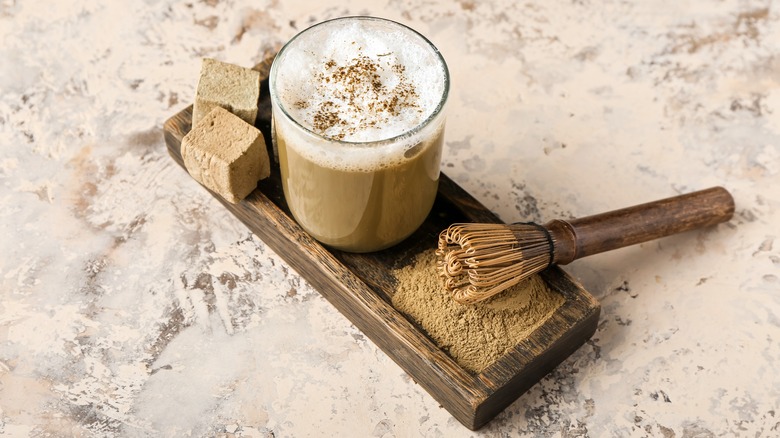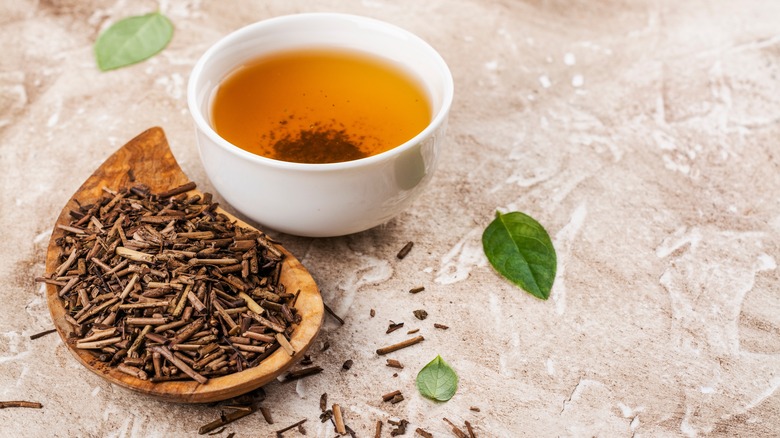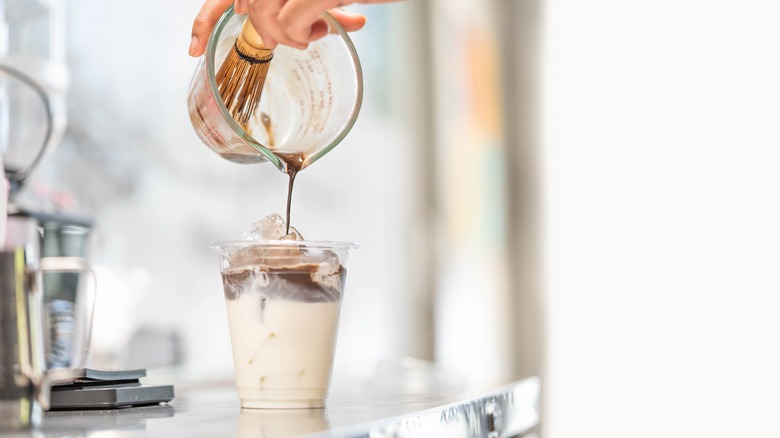Hojicha Is The Matcha Latte-Alternative You Need To Start Sipping
Matcha's popularity has long transcended the world of teas for the green powder is now used to flavor all kinds of breakfasts, desserts, cocktails, and even savory preparations, much to everyone's delight. While the fascination with all things matcha doesn't seem like it's going anywhere anytime soon, there are other teas slowly following in its footsteps, particularly hojicha — which is quickly gaining favor and deservedly so.
Hojicha has much in common with matcha in that they are both Japanese green teas, but that is where the similarities end. Hojicha translates to roasted tea, and this indicates how the tea is made. While matcha is made by grinding green tea leaves in a stone mill known as ish-iusu, hojicha is made by roasting the leaves (along with their stems, stalks, and twigs) over charcoal until the tea darkens from green to a shade of reddish-brown. While this affects hojicha's flavor immensely, there is more that gives it a certain edge over matcha.
Those who prefer matcha over coffee for its lower caffeine content will find that hojicha is an even better alternative. While matcha can have upwards of 35 milligrams of caffeine per cup, roasting strips hojicha's caffeine down to as little as 8 milligrams. Plus, hojicha has all the benefits of green tea that matcha does and more because roasting also gives it pyrazine — a chemical that can improve digestion as well as blood circulation (via Matcha).
The origin of hojicha and what it tastes like
Hojicha may be a Japanese green tea like matcha, but it is quite unlike any other tea for more reasons than one. Hojicha originated in the 1920s, and it was invented not for its taste or health properties. As Japan transitioned from manual to mechanical tea production to meet rising global demand, it faced an unprecedented problem: Machines produced a ton of waste and left an excess of low-grade green tea leaves as well as stems, twigs, and stalks that needed to be disposed of.
Hoping to put these scraps to use, a tea merchant decided to roast them over charcoal and brew them into a tea, only to find that the tea's smoky aroma alone was enough to entice tea drinkers. And so hojicha was born. Because hojicha is essentially made from whatever remains after green tea production, its flavor will vary depending on what was used in its making — it could have a base of sweet early-harvest tea or bitter tea harvested later in the season.
What is certain is that roasting these leftovers gives hojicha a rich umami flavor that is more smoky, nutty, and sweet than matcha — with notes of chocolate or caramel. Plus, roasting also rids hojicha of some of its tannins, so it is less astringent and ideal for anyone who doesn't quite fancy matcha's bitter flavor.
How to drink hojicha
There are typically two ways to brew hojicha: It can be steeped in hot water as a loose-leaf tea or whisked into a latte in its powdered form like matcha. To make a latte, whisk a teaspoon of hojicha powder in hot water till it turns foamy. Pour the mixture in hot milk for a steamy hojicha latte or use cold milk and ice for a chilled version — though the ice will dilute some of hojicha's flavor.
Feel free to skip on the sweeteners when making the latte — hojicha already has an inherent sweetness to it, unlike matcha. Another way to brew hojicha is to steep loose leaves in an infuser or a teapot, or use tea bags and brew those in hot water.
No matter which method you choose, there are a few things to keep in mind. Roasting gives hojicha a robust flavor that can quickly turn bitter when exposed to hot water for too long, so it should be steeped in hot water for no longer than a minute. Additionally, a batch of loose-leaf hojicha leaves can and should be stepped in hot water multiple times. Hojicha has an incredible depth of flavour and each round of brewing will bring out different elements of the complex tea. Use the same amount of water but steep the tea leaves for longer each time so that they have enough time to fully infuse their flavor before you sit back and enjoy the tasty drink!



